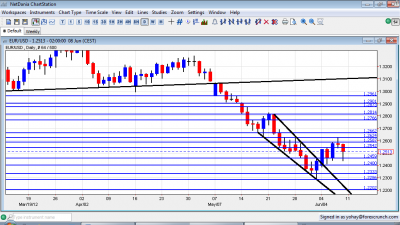Euro/dollar recovered nicely as leaders finally seemed to wake up and encounter the Spanish crisis. Can this hope continue for another week, before the Greek elections? The upcoming week consists of important inflation and industrial output indicators. Here is an outlook for the upcoming events and an updated technical analysis for EUR/USD.
Updates: the EU decided on a Spanish bailout worth up to €100 billion. This could be cheered by the markets, but probably for a short time, as there are 8 holes in the Spanish bailout. The ECB, which is the single most powerful factor, hasn’t offered any help. Is it waiting for politicians to move first? This is part of the hope in the markets for now. Also the chances for more money dropping from the US are lower as well, after Bernanke didn’t provide any hints about QE3, and even said that “returns are diminishing“. French Industrial Production surprised the markets with a 1.5% jump, its best figure since September 2011. The euro has fallen after the initial euphoria over the Spanish bailout, and was trading at 1.2556. French Final Non-Farm Payrolls grew by a very modest 0.1%, matching the market estimate. The euro continued to fall, as EUR/USD was struggling to stay above the 1.25 line. The pair was trading at 1.2509. Trouble in the Spanish banking sector continue, despite the bailout. On Monday, the Fitch ratings agency downgraded the credit rating of Spain’s two largest international banks, Banco Santander and Banco Bilbao Vizcaya Argentaria, from A to BBB+. French CPI dropped 0.1%, below the market forecast of a 0.2% gain. German Final CPI declined 0.2%, matching the market estimate. Euro-zone Industrial Production posted a weak reading of -0.8%, a four-month low. The German 10-y Bond Auction took place today. The auction posted results of 1.52|1.4. EUR/USD continues to be choppy. The pair was trading at 1.2546. Italy plans to auction at least 9.5 billion euros ($11.9 billion) of debt this week. The yield on Italian 10-y bonds is already up to 6.3%, which could spell fiscal trouble ahead. German WPI fell below the market forecast, declining 0.7%. Euro-zone CPI came in at 2.4%, matching the market estimate. The Core CPI recorded a 1.6% increase, just below the forecast of 1.7%. The ECB released its monthly bulletin. Spain’s 10-year bond yields hit a euro-era record of 7 percent, as concerns continue on the country’s ability to service its debt. Italy auctioned off EUR4.5 billion in government bonds on Thursday. The markets are very concerned about the high cost of the debt, as the yield on 10-year bonds has now risen to 6.30%.
EUR/USD daily chart with support and resistance lines on it. Click to enlarge:
- French Industrial Production: Monday, 6:45. Europe’s second largest economy has experienced a drop of 0.9% in industrial output, following a rise in the same scale. A small rise is expected for the month of April: +0.2%.
- German Final CPI:Wednesday, 6:00. According to the preliminary release, prices fell in May by 0.2%. This will probably be confirmed. More price falls will enable a rate cut in July.
- Industrial Production: Wednesday, 9:00. After Germany disappointed with a significant drop of 2.2% in its output, the figure for the whole euro-area will likely be negative as well, following a drop of 0.3% last month. Expectations stand on a drop of 0.9%.
- German WPI: Thursday, 6:00. German inflation still plays an important role in the ECB’s rate decision, so that also the Wholesales Price Index is of importance. After a rise of 0.5% last month, another small rise is expected now: +0.4%.
- ECB Monthly Bulletin: Thursday, 8:00. One week after Draghi introduced updated growth and inflation reports, we will get a wider picture of the situation, as the ECB members saw it in their meeting. This publication tends to move the euro.
- CPI:Thursday, 9:00. The initial CPI estimate was a bit below expectations: 2.4%. However, this is still above the target. The 2.4% will likely be confirmed now, and Core CPI will likely stand on 1.6%.
- Employment Change: Friday, 9:00. This is a rather late figure, reflecting the change in Q1. Nevertheless, it can give a wider picture. Employment fell by 0.2% in Q4 and has likely fallen as well in Q1, by another 0.2%.
- Trade Balance: Friday, 9:00. The euro-zone, as a whole, had a surplus of 4.3 billion euros last time. Germany’s surplus is around 3 times this figure. So without Germany, the deficit would be wide. A similar figure is expected now: 4.2 billion.
* All times are GMT
EUR/USD Technical Analysis
Euro USD started the week by trading between 1.24 and 1.2540. It then broke higher but couldn’t make a move above the all-important 1.2624 line (mentioned last week). It then lost the high range and eventually closed at 1.2513.
Technical lines from top to bottom:
1.2873 is the previous 2011 low set in January, and it is distant resistance now. This is a very strong line separating ranges, as also seen in May 2012. 1.2814 is now stronger after being a clear line separating ranges in May 2012.
1.2760 is a pivotal line in the middle of a trading range seen earlier.. It provided support early in the year and is now of high importance. 1.2660 was a double bottom during January and the move below this line was confirmed after a struggle.
1.2623 is the previous 2012 low and remains important. Attempts to rise above this line have failed, including in June 2012. This is a critical resistance line separating ranges . Below, 1.2587 is a clear bottom on the weekly charts but is only minor resistance now.
1.2540 served as minor resistance and also support in June 2012. 1.2460 is minor support after stopping a euro rally in June 2012.
1.24. It provided some resistance in June 2010 and is now minor support. 1.2286 is a new minor line of support after being the swing low in June 2012.
Further below, 1.2330 is another historical line after being the trough following the global financial meltdown in 2008. The new 2012 low of 1.2288 is minor support now.
1.22 is minor support below, after serving as such in June 2010. 1.2144 is already a very strong line on the downside: it was a clear separator two years ago, when Greece received its first bailout.
The round number of 1.20 is of course highly important in the psychological level. Below, the 2010 trough of 1.1876 is apparent, before the launch value of the euro at 1.17 to the dollar in 1999.
Steep Downtrend Channel Broken
The steep downtrend channel mentioned last week was clearly broken to the upside.
I am neutral on EUR/USD
Has Germany really bent for the euro? Is it becoming more flexible on Spanish aid, eurobonds and a fiscal union like it is pressured to? This is still to be seen. In the meantime, some stability on hope for global action can be expected before the Greek elections on June 17th. Afterwards, it’s a different story.
In Greece, thing are beginning to collapse. the state’s coffers are running dry as Greeks defer tax payments and even providing electricity is becoming challenging.,Also pharmacies are in a grave situation The implications of a Grexit for the European banking system and for other countries are not fully priced in. Here’s how to trade the Grexit with EUR/USD.
If you have interest in a different way of trading currencies, check out the weekly binary options setups, including EUR/USD, GBP/JPY and more.
Further reading:
- For a broad view of all the week’s major events worldwide, read the USD outlook.
- For the Japanese yen, read the USD/JPY forecast.
- For GBP/USD (cable), look into the British Pound forecast.
- For the Australian dollar (Aussie), check out the AUD to USD forecast.
- For the New Zealand dollar (kiwi), read the NZD forecast.
- For the Swiss Franc, see the USD/CHF forecast.
- USD/CAD (loonie), check out the Canadian dollar forecast.

